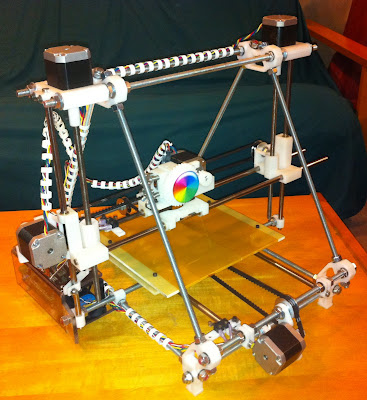This post is just meant to cover some of the unexpected issues that came up during my build. The
visual instructions for the mechanical part of the project that are available on Gary Hodgson's site are fantastic. I swear it wasn't more than a week after I finished the mechanical build that he posted that guide. There were some really nice YouTube videos linked from the reprap.org site for the Prusa Mendel that I used but the links seem to have gone AWOL (or I'm looking in the wrong place). I'm sure a quick search would find them.
 |
| Notched fender washer |
Building the triangles and the horizontal connecting rods went great. Then I jumped ahead and tried to mount the Y-motor (that's the one in the front on the bottom if you go the traditional route), and found that the left fender washer in front was in the way of the mounting hole for the stepper motor. I still can't figure out what I did differently that made this a problem for me. So I ended up disassembling that front rod, cutting out a notch in the fender washer and reassembling. Oh, and this was after getting everything I had done so far squared up and spaced evenly.
At this point I realized I should have gotten my bushings into their bushing holders and put them onto the Y-axis smooth rods. I reamed the bushing holders, inserted the bushings, and tested them on the smooth rods. I wasn't real happy with the less than super smooth movement, so a coworker threw the rods on a lathe and really polished them up. It made a huge difference.
 |
| Normal vs. nylock #6 nut |
This is when I first noticed something completely missing from the vitamins list. For the top of the Z-axis smooth rods and the captive nuts in the X ends, there was no way the nylock nuts were going to fit. I don't know if my #6 nylock nuts or plastic parts are atypical, but I found some "normal" #6 nuts and used those. So I needed 12 non-nylock nuts (4 for top of Z smooth rods, 8 for X ends), and I used another 2 later to mount my extruder.
 |
| Captive nut in X-end idler |
One thing I wasn't thrilled with here was that there only seemed to be 2 layers of plastic holding the nuts captive in the X ends. It didn't take much tightening on the bolts to cause the plastic to start to deform. So I just tightened them as much as I though I could get away with that wouldn't crack the plastic.
Next came my first experience with gluing the bushings. I didn't see any guidance as to what glue to use other than to go with a two-part epoxy. I chose the Loctite epoxy for plastics. I probably didn't use enough the first time because in trying to move the X-axis down to get the Z lead screws in, three of the bushings came off. I used a lot more epoxy the next time and it has held so far.
 |
| Nice Delrin coupler (thanks Gary!) |
I had planned to use the printed couplers for the top of the Z lead screws temporarily until I could make up something better, but for some reason the hole to accept the threaded rod was way too big. Even clamped as far as it could go, there was still close to an 1/8" gap. Coworker to the rescue again. Gary whipped up a pair of couplers out of Delrin for me which have worked out great.
It wasn't until I got the Z lead screws mounted that I realized just how lousy the standard threaded rod I had was for this purpose. I didn't think there was any point in trying to straighten it as it would clearly have a serious impact on the quality of my prints. So I ended up ordering a couple of one foot pieces of stainless threaded rod and it was much better.
When it was time to run the Z lead screws through the nuts in the X ends, I found that the nice silicon-bronze nuts I had gotten were too small on the outside to fit snuggly in the hexagonal hole. Even though the Z-axis would only be going one way during a print, it didn't seem right to have the nuts loose in there. So I ended up using some zinc jam nuts that fit in there without any play.
 |
| Bottom view of build plates |
One last particular of my mechanical construction: I opted to use G10 (a fiberglass-resin composite) for the bed surfaces. There were plenty of good sized scraps of it available at work. I planned on doing a heated bed at some point, but I thought this would make a great unheated surface as it's really smooth and won't wick away the heat from PLA as quickly as aluminum. You can see in the picture that I had the bottom plate open in the middle to try to keep the weight down. Gary (did I mention I owe him at least a case of his favorite beer?) cut out the bottom plate for me and milled some nice pockets for the bushing holders. I wrapped the belt around the sides of the plate in order to keep it from slipping.
Everything else on the mechanical side went just as expected. Well, until I got to the extruder anyway. But I didn't work on that until after some electronics work.











